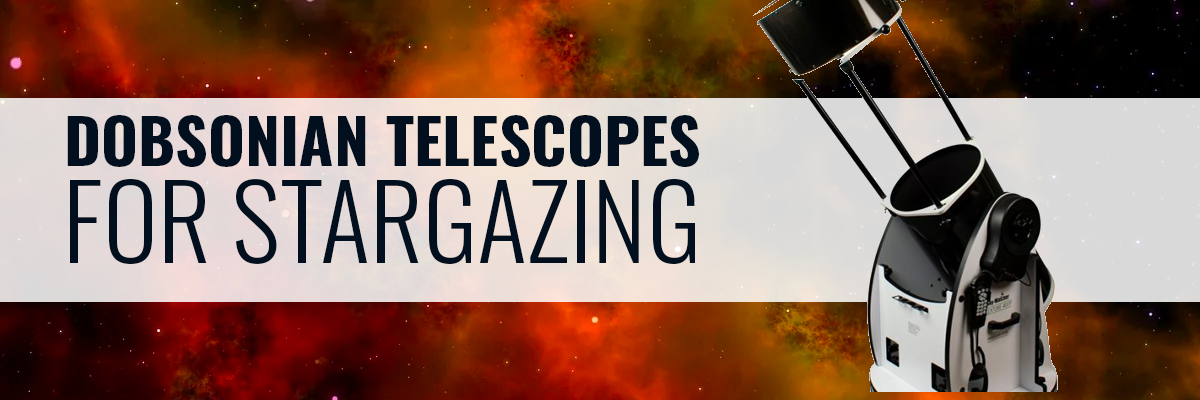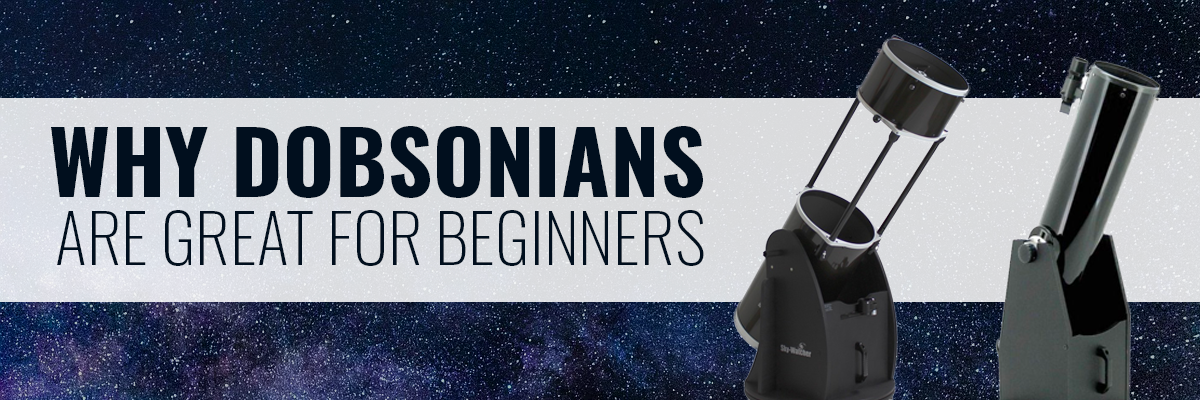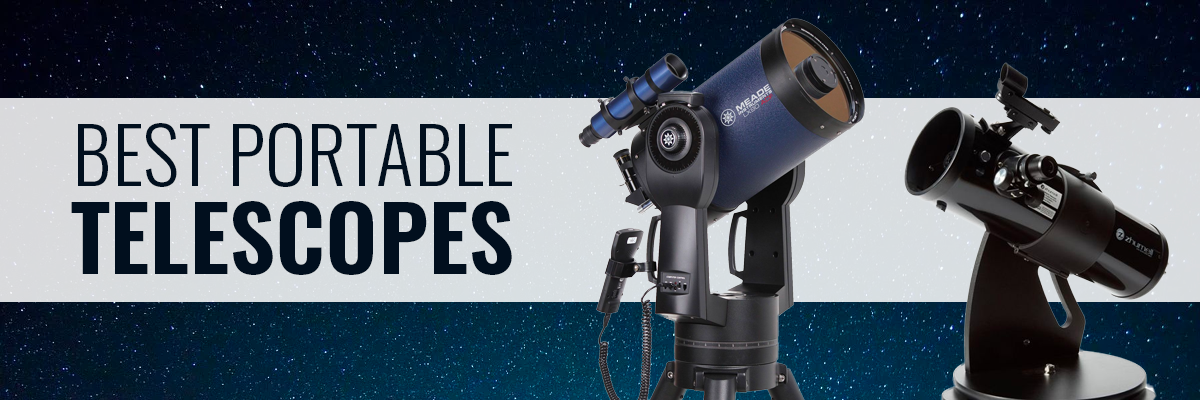Dobsonian Telescope Knowledge Center
WHAT IS A DOBSONIAN TELESCOPE?
The traditional Dobsonian telescope has two components, the telescope tube assembly and the base. The Dobsonian telescope tube assembly is a classic Newtonian. A Newtonian telescope uses mirrors to collect starlight and direct that light to your waiting eye. The biggest mirror, located in the rear of the tube and responsible for light-gathering, is called the primary, and the smaller mirror placed further up is called the secondary. It is responsible for reflecting the light gathered by the primary mirror through the focuser and eyepiece to your eye. This is how all Newtonian telescopes work, regardless of the mount or base they ride on.
What makes a Dobsonian telescope different from other Newtonians is the base, which was invented by John Dobson several decades ago. The Dobsonian base has a simple alt-azimuth rocker box design with a heavy-duty rotating lazy-suzan underneath. The telescope tube has a round disk mounted on each side and they sit in a cradle cut into both sides of the base. Once the telescope tube is installed in the base, it is super simple to move the Dobsonian up and down or back and forth! Kids can learn how to use a Dobsonian telescope on their own quickly, and bonus, there are no tripod legs to trip over in the dark!
The ease-of-use and relative affordability for a telescope with larger mirrors make Dobsonian telescopes great for beginners, but there are plenty of advanced amateur astronomers who love their Dob and, even if they bought another telescope at some point for astrophotography, would never give it up!
WHAT IS THE BEST DOBSONIAN TELESCOPE FOR SALE?
There is no such thing as the "best Dobsonian". The best Dobsonian for you could be too big (or too small) for someone else. If money or extreme portability are not a consideration, choose at least an 8 inch Dobsonian Telescope so you can see more details in deep-sky objects. If you want to go bigger, consider the weight of each telescope component (tube and base) to make sure you can set it up easily. Dobsonian manufacturers have used a few tricks to make big models more portable, such as designing a truss tube Dobsonian or a collapsible Dobsonian! In other words, you may be able to buy a bigger Dobsonian than you could get away with in other telescope designs, so check that out if you are interested.
Besides the size of the mirror and weight of the telescope, there are several other things to consider when buying a Dobsonian telescope. You could get a computerized GoTo Dobsonian that will find celestial objects for you, you could buy a classic Dobsonian telescope that is completely manual, just like the one John Dobson invented, or you could choose a collapsible Dobsonian or a Truss-Tube Dobsonian Telescope for extra portability. Finally, you could always decide on a Dobsonian telescope kit! These Apertura Dobsonian telescope bundles come with extra accessories, like a moon filter, Barlow or extra eyepieces to give you more observing pleasure right out of the box.
For more on Dobsonian telescopes, check out our guide to the best Dobsonian telescopes for stargazing.
WHAT ARE DOBSONIAN TELESCOPES GOOD FOR?
Most Dobsonian telescopes are good for looking at deep-sky objects, including galaxies, nebulae and dim star clusters, but they also work great for enjoying the Moon and planets! The aperture (diameter of the primary mirror) of the telescope is the main factor that dictates how much detail you can see, especially when looking at celestial objects out of our Solar System. As a general rule, we recommend an 8 inch Dobsonian Telescope or larger to enjoy a wide range of deep-sky objects.
DIFFERENT STYLES OF DOBSONIAN TELESCOPES
A truss tube Dobsonian increases portability for big Dobs by using truss poles in the center portion of the telescope tube assembly. A lot of weight is removed by using a truss tube design when compared to the closed optical tube of a traditional Dobsonian. The cool thing about truss tubes is how they can turn a big, heavy telescope into an instrument that most adults can handle. To set up or break down a Truss Tube Dobsonian Telescope, simply lift off the top section that includes the focuser and secondary and remove each truss pole. Once you have separated the optical tube into two main components (not counting the truss tubes) the amount of weight you have to carry will decrease and each section will be more portable for storage and transport. If you are concerned about the weight or bulkiness of a big Dob, the truss tube design is a game-changer!
A good example of this Dobsonian telescope design is the Explore Scientific Truss Tube Dobsonian Telescope in a 10” aperture. Explore Scientific and Orion both offer several aperture choices for truss tube telescopes.
A collapsible Dobsonian is very similar to a truss tube Dobsonian; in fact, it is common to confuse the two. Here is the difference: To break down a truss tube Dobsonian, the user removes the truss poles completely. However, with a collapsible Dobsonian telescope, the truss poles do not come out, but rather slide into the bottom part of the telescope tube assembly! It is a very neat trick that shortens the telescope considerably for travel, transport and storage, making a larger aperture Dob a more portable telescope.
A good example of this telescope design is the Sky-Watcher 12 Collapsible Dobsonian. Sky-Watcher makes a selection of their Flextube collapsible Dobs, and in fact, most of them are computerized with their SynScan GoTo system.
The classic, or solid tube Dobsonian has been around for about half a century and is the most popular Dobsonian style on the market. The classic is the best Dobsonian design for keeping dew off of the primary mirror, and because this telescope sports a long solid tube, it also keeps contrast-reducing stray light from hitting the primary. Setting up and breaking down a Classic Dob is easier and faster as well!
A great example of a classic Dobsonian is the Apertura AD8, our most popular 8 inch Dob, but there are lots of solid tube Dobsonians to choose from in sizes from tabletop to a 12” deep-sky light bucket!
If you want an economical, highly portable telescope that has decent aperture, a tabletop Dobsonian should be high on your list of possibilities. Because Dobsonians are designed with a short rocker box base instead of a tripod, a smaller, portable Dobsonian telescope is way easier to look through when sitting on a table or other raised, flat surface. Once Dobsonians get to about 6” in aperture they are tall enough to use comfortably for most people when sitting on the ground.
Imagine using a portable Dobsonian telescope like the Sky-Watcher Heritage 130 on a camping trip! It has enough aperture (5 inches) to see brighter galaxies and other deep-sky objects as well as the Moon, Saturn, Jupiter and Mars, and the tube collapses down to shorten it by half. Just set this portable Dob on a picnic table, insert an eyepiece, and gaze at the wonders of the Universe!
If you like the idea of a big aperture Dobsonian Telescope but also want help locating celestial objects, a computerized GoTo Dobsonian is for you! Dobsonian telescopes were originally designed to be completely manual, but over the years many telescope users, especially those who enjoyed the challenge of building their own Dob, added motors, push-to systems, tracking platforms, and more to make finding objects and keeping them centered in the eyepiece much easier. Today, amateur astronomers can buy a fully decked out Dobsonian that is capable of finding and centering thousands of objects.
If you are wondering whether you can do astrophotography with a GoTo Dobsonian, the answer is yes and no. While Dobsonian telescopes are not designed for astrophotography due to their simplistic alt-azimuth mount, a determined user could take photos of the moon, bright planets and a handful of bright deep-sky objects with a GoTo Dobsonian. The set up wouldn’t be optimum, but it could be done. However, in order to do exposures longer than a few minutes, any telescope mount needs to be aligned with the celestial pole. Unfortunately, an alt-azimuth mount, regardless of the computerization, cannot be polar aligned. High Point does not recommend any type of Dobsonian or Alt-Az telescope for deep-sky astrophotography due to the above limitations. If you need help choosing a telescope for astro-imaging, a non-commissioned product advisor would be happy to help!
A popular example of a GoTo Dobsonian is the Sky-Watcher SynScan 8. This Sky-Watcher computerized 8 inch Dob is collapsible for portability and will help you explore hundreds of celestial objects with the tried and true SynScan AZ GoTo System.
DIFFERENT SIZES OF DOBSONIAN TELESCOPES
Below is a list of the most common Dobsonian telescope apertures and how they compare to one another when it comes to light-gathering capabilities. Light-gathering is a main factor in dictating how many celestial objects you can see and how much detail you can discern in those objects. Unfortunately, more light-gathering also means higher prices and a larger, heavier telescope. So be careful not to fall victim to “aperture fever” and buy the biggest telescope you can without considering other factors! Instead, find a balance between aperture, the weight of each telescope component, and your budget.
RELATED TELESCOPES & ARTICLES



